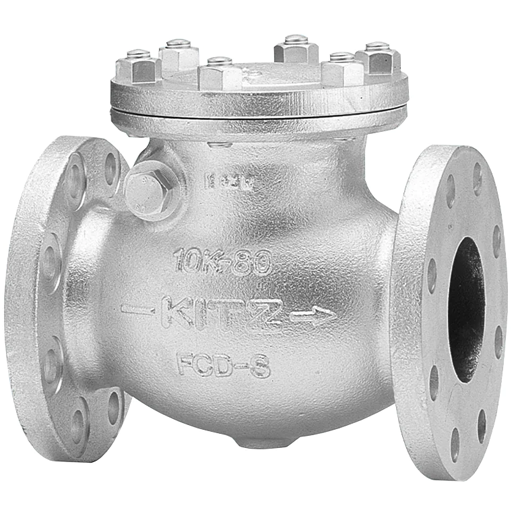
The check valve is a valve that constantly maintains fluid flow in a constant direction and prevents reverse flow. The disc is pushed open by the fluid pressure, but when it flows backward, the disc is brought into close contact with the seat of the body by the back pressure to prevent backflow. There are three typical types of check valves (swing check valve, lift check valve, and wafer check valve).

This section introduces the operation principle for flowing and stopping the fluid of three types of check valves.
Swing check valve
One end of a disc-shaped disc is made into a “wing-type” structure, which is free to move by hanging on a body, etc., and has a structure in which pressure loss is small and fluid flows easily. It can be used not only for horizontal piping, but also for vertical piping (flowing from bottom to top).
The product information of the swing check is included in the valve catalog for each material.
Select the valve material and refer to the catalog.
Cast Steel Swing Check Valves (with internal hinge pin)
- No risk of leakage from a hinge pin plug
- Anti rotation disc design
- Same face to face dimensions and flow characteristics as the current design
- Meets the latest editions API 594: 2017


Product Range
| Class | Product code | 1½ | 2 | 2½ | 3 | 4 | 5 | 6 | 8 | 10 | 12 | 14 | 16 | 18 | |
|---|---|---|---|---|---|---|---|---|---|---|---|---|---|---|---|
| Stainless | 150 | 150UOCH | ○ | ○ | ○ | ○ | ○ | ○ | ○ | ○ | △ | △ | △ | ||
| 300 | 300UOCH | ○ | ○ | ○ | ○ | ○ | ○ | ○ | △ | △ | |||||
| 600 | 600UOCH | ○ | ○ | ○ | ○ | ○ | ○ | ○ | |||||||
| Cast Steel | 150 | 150SCOHS | ○ | ○ | ○ | ○ | ○ | ○ | ○ | ○ | ○ | ○ | ○ | ○ | ○ |
| 300 | 300SCOHS | ○ | ○ | ○ | ○ | ○ | ○ | ○ | ○ | ○ | ○ | ○ | ○ | ○ | |
| 600 | 600SCOHS | ○ | ○ | ○ | ○ | ○ | ○ | ○ | ○ |
Lift check valve
The stem, handle, and other open/close operation parts are removed from the globe valve, and the cover is attached. Major products are those with large fluid resistance and small bore size.

The product information of the lift check is included in the valve catalog for each material.
Select the valve material and refer to the catalog.
Wafer check valve
The body is wafer-shaped, making it much thinner and lighter than conventional shock-absorbing check valves. This is a multi-functional, high-performance shock-absorbing check valve with a built-in bypass circuit and excellent sealing performance, despite being a thin-type boiler.

Water hammer reduction
The independent spring mechanism is an impact-absorbing check valve that suddenly closes immediately before reverse flow of fluid and reduces water hammer generation. This valve protects piping equipment such as pumps.
Pump can be mounted directly
The pump can now be mounted directly on the disc by adjusting the opening of the disc appropriately and changing the national method for inserting the pin of the disc and the pin to improve durability.
Easy-to-handle wafer type
Although it is a thin body, it has a built-in bypass circuit, greatly streamlining the piping design and construction.
Easy-to-handle wafer type
Thin and lightweight, the installation space is small and installation work can be performed rationally.
Excellent sealing performance
Rubber seat (standard: NBR) and spring mechanism provide excellent sealing performance not found in conventional catch valves.
The product information of the wafer check is included in the valve catalog for each material.
Select the valve material and refer to the catalog.
Caution: Direct Mounting of Pump
*Stainless steel copper products have a different structure, so they cannot be directly connected to the pump. Secure a straight pipe section with a 2D or more (or a 3D or more if there is a 2-size expansion in the pump discharge) in front of and behind the product.
KITZ wafer catch valve is an impact-absorbing check valve specified in the Standard Specifications for Public Building Works.
We also offer products certified by the Fire and Safety Centre, as well as those certified by the Japan Water Works Association and those certified by SAS358 Standard.
- The Standard Specification for Public Building Works specifies that check valves attached to pumping pumps and air-conditioning pumps shall be “shock-absorbing type with bypass valves and if the total head exceeds 30m.
- Select springs suitable for the operating conditions. Use outside this range may cause vibration noise. Refer to “Spring Selection Criteria” (P5).
